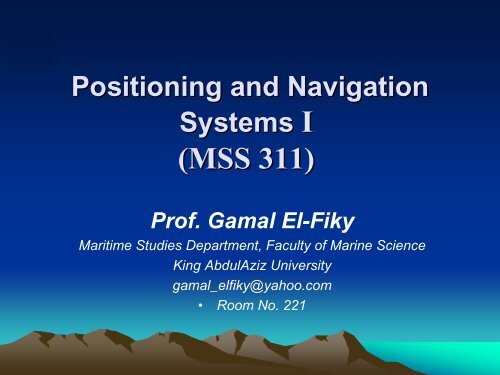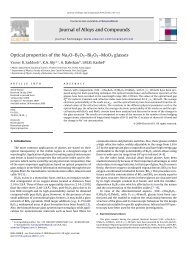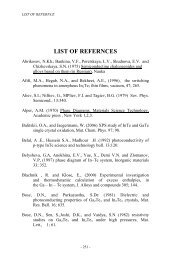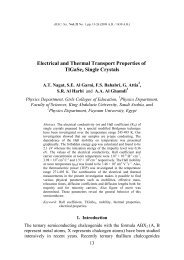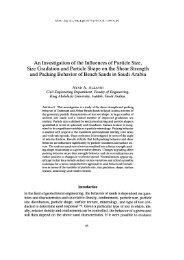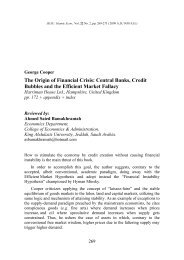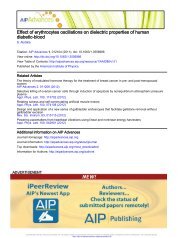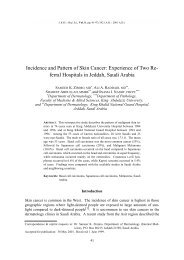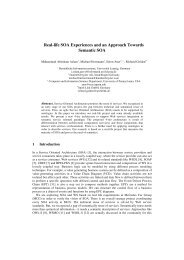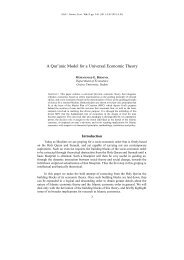The Compass Errors
The Compass Errors
The Compass Errors
You also want an ePaper? Increase the reach of your titles
YUMPU automatically turns print PDFs into web optimized ePapers that Google loves.
Positioning and Navigation<br />
Systems I<br />
(MSS 311)<br />
Prof. Gamal El-Fiky<br />
Maritime Studies Department, Faculty of Marine Science<br />
King AbdulAziz University<br />
gamal_elfiky@yahoo.com<br />
•<br />
Room No. 221
Chapter 3<br />
<strong>The</strong> Marine Magnetic<br />
<strong>Compass</strong>
•<br />
•<br />
Magnetic <strong>Compass</strong><br />
<strong>The</strong> magnetic compass still retains its<br />
importance despite the invention of the<br />
gyro-compass. While the latter is an<br />
extremely accurate instrument, it is<br />
relatively expensive, highly complex,<br />
dependent on an electrical power supply,<br />
and subject to mechanical damage.<br />
<strong>The</strong> magnetic compass is less expensive,<br />
entirely self-contained, fairly simple, and<br />
not easily damaged.
•<br />
•<br />
•<br />
•<br />
What We’ll We ll Cover<br />
<strong>Compass</strong> design<br />
Principles of operation<br />
Deviation & swinging ship<br />
<strong>Compass</strong> calculations
Parts of a <strong>Compass</strong><br />
Constructed of nonmagnetic<br />
materials.
Parts of a <strong>Compass</strong><br />
Indexed card to read<br />
direction.
Parts of a <strong>Compass</strong><br />
Lubber line pins to<br />
align compass with<br />
boat.
Parts of a <strong>Compass</strong><br />
Gimbal system to keep<br />
card level when ship<br />
heels and pitches.
Parts of a <strong>Compass</strong><br />
Spherical bowl with<br />
expansion diaphragm.
Parts of a <strong>Compass</strong><br />
Fluid filled damping<br />
system to impede<br />
rapid card movement.
Parts of a <strong>Compass</strong><br />
Compensation system<br />
to reduce deviation<br />
error.
Steering <strong>Compass</strong> Styles<br />
Top Reading Card<br />
Usually used in binnacle<br />
steering stations.<br />
Front Reading Card<br />
Used when compass<br />
mounted on bulkhead.
Hand Bearing <strong>Compass</strong> Styles<br />
Front/Top Reading
•<br />
•<br />
•<br />
•<br />
•<br />
<strong>Compass</strong> Card<br />
Graduated in degrees from 000 to<br />
359.<br />
Graduated in 1, 2, 5 degree<br />
increments.<br />
Numbers spaced every 10-30<br />
degrees.<br />
Usually show cardinal points: N, S,<br />
E & W.<br />
May show intercardinal points: NE,<br />
SE, SW & NW.
<strong>Compass</strong> <strong>Errors</strong><br />
Deviation and Variation<br />
<strong>The</strong> unattractive Truth<br />
…<br />
<strong>Compass</strong>es don’t don<br />
point to True North!
•<br />
Variation: (Magnetic rose)<br />
<strong>Compass</strong> <strong>Errors</strong><br />
It is the difference at any location between the directions<br />
of the magnetic and true meridians.<br />
– Geographic (true) vs. magnetic north.<br />
– Common to all parts of the globe.<br />
– Identified on every chart’s compass rose's.<br />
•<br />
Deviation: (From deviation tables)<br />
It is the divergence between the N-S axis of<br />
the compass card and the magnetic meridian.<br />
– Caused by shipboard magnetic influences.<br />
– Exists on all vessels; different for each vessel.<br />
– It varies widely.<br />
<strong>The</strong> <strong>Compass</strong> <strong>Errors</strong>: <strong>The</strong> algebraic sum of variation<br />
and deviation<br />
C.N<br />
M.N<br />
Dev. Var.<br />
T.N
•<br />
Example:<br />
If the variation was 05° 55‘ W (in 1979),<br />
decreasing about 4‘ annually, calculate variation<br />
in year 2008.<br />
Solution:<br />
2008<br />
1979<br />
0029 years × 4‘=116‘= 01° 56‘<br />
<strong>The</strong>n: Var. (1979)= 05° 55‘ W<br />
-01° 56‘<br />
03°59‘ W
•<br />
Earth -<br />
Variation:<br />
A Magnet<br />
Locating exact source of<br />
magnetism difficult.<br />
– Alignment of magnetism<br />
changes.<br />
– Strength of pull varies<br />
over earth.
•<br />
•<br />
•<br />
•<br />
•<br />
•<br />
•<br />
•<br />
•<br />
•<br />
•<br />
Deviation Table (1)<br />
<strong>Compass</strong> Course Deviation <strong>Compass</strong> Course Deviation<br />
000°<br />
010°<br />
020°<br />
030°<br />
040°<br />
050°<br />
060°<br />
070°<br />
080°<br />
090°<br />
C 4.0°<br />
C 3.0°<br />
C 2.0°<br />
C 0.4°<br />
C 1.2°<br />
C 2.2°<br />
C 3.0°<br />
C 4.2°<br />
C 5.4°<br />
C 4.3°<br />
E 180°<br />
E 190°<br />
E 200°<br />
E 210°<br />
W 220°<br />
W 230°<br />
W 240°<br />
W 250°<br />
W 260°<br />
W 270°<br />
C 3.1°<br />
C 2.2°<br />
C 0.6°<br />
C 2.0°<br />
C 3.2°<br />
C 4.4°<br />
C 5.6°<br />
C 4.0°<br />
C 3.4°<br />
E<br />
E<br />
E<br />
W<br />
W<br />
W<br />
W<br />
W<br />
W<br />
C 2.1° W
•<br />
Example (1)<br />
Find the deviation of course 217°.<br />
Solution:<br />
<strong>Compass</strong> C. Deviation<br />
210°<br />
2.0° W<br />
220°<br />
3.2° W<br />
10 1.2<br />
03 X<br />
<strong>The</strong>n Deference of Dev.= 3×1.2/(10)=0.36°<br />
So, Deviation of Course 217° = 3.2-0.36 = 2.84°W
•<br />
Examples (2 & 3)<br />
If the variation is 3°E, and the deviation is 2°E. Calculate<br />
the compass error?<br />
Solution:<br />
Variation = 3°E<br />
Deviation = 2°E<br />
<strong>Compass</strong> error = ΣVariation + Deviation = 3 +2 = 5°E<br />
•<br />
If the variation is 4°W, and the deviation<br />
is 2°E. Calculate the compass error?<br />
Solution:<br />
Variation = 4°W<br />
Deviation = 2°E<br />
<strong>Compass</strong> error = -4 + 2 = 2°W<br />
T.N<br />
Var.<br />
M.N<br />
Dev.<br />
C.N
•<br />
Examples (4 & 5)<br />
If the C Bearing = 052°C, Var. 4°W and the Dev. = 1°E. Calculate<br />
True Bearing.<br />
Solution:<br />
Variation = 4°W C. Bearing = 052°C<br />
Deviation = 1°E C. error = 3°W<br />
<strong>Compass</strong> error = 3°W T. Brg. =049°<br />
•<br />
If the compass Bearing is 028°C, and the true Bearing is 025°T,<br />
Find the <strong>Compass</strong> error.<br />
Solution:<br />
T. Brg. = 025°T<br />
C. Brg. = 028°C<br />
<strong>Compass</strong> error = 003°W<br />
Note: (If C less than T the error is East and if C<br />
greater than T is West.
•<br />
•<br />
•<br />
Deviation:<br />
Ship-Specific Ship Specific Error<br />
Due to on-board magnetic influences:<br />
–<br />
–<br />
–<br />
Magnetic items<br />
Items to which magnets are attracted.<br />
Wires carrying DC electrical current.<br />
Reduce effects as much as possible:<br />
–<br />
–<br />
Keep compass away from influences<br />
Twist nearby DC wire pairs.<br />
Usually can’t eliminate them all.
Additive Effect<br />
of <strong>Compass</strong> <strong>Errors</strong><br />
Error due to<br />
015° W<br />
variation<br />
Additional<br />
error due to<br />
005° W<br />
deviation<br />
Desired True<br />
heading<br />
<strong>Compass</strong><br />
heading must be<br />
adjusted 020° to<br />
compensate.
•<br />
•<br />
Measuring Deviation<br />
Yourself<br />
By using Deviation table or Curve we can obtain<br />
the deviation value of a specific <strong>Compass</strong> course.<br />
First you have to know how to do some compass<br />
calculations.
•<br />
•<br />
•<br />
•<br />
Compensation<br />
Deviation often greater than 10º.<br />
Special magnets (compensators) installed<br />
in compasses to reduce error.<br />
Most compasses come with instructions.<br />
Can still have significant deviation<br />
error after compensation.
+W<br />
T<br />
V<br />
M<br />
D<br />
C<br />
Computing<br />
<strong>Compass</strong> Corrections<br />
True Heading<br />
Variation on Chart<br />
Magnetic Heading<br />
Deviation<br />
<strong>Compass</strong> Course<br />
000<br />
015 W<br />
015<br />
005 W<br />
020
•<br />
•<br />
Isogonic<br />
Chart<br />
Illustrates<br />
magnetic<br />
variation<br />
(1995)<br />
World-Wide World Wide Variation
•<br />
•<br />
•<br />
•<br />
•<br />
“Swinging Swinging Ship” Ship<br />
Process of measuring residual deviation<br />
error after compensation.<br />
Usually determined in 15º - 30º heading<br />
increments.<br />
Recorded in form of deviation table.<br />
<strong>Compass</strong> adjuster can provide service.<br />
Or, you can do it yourself ...
•<br />
•<br />
•<br />
Back to<br />
Measuring Deviation<br />
For each 15º<br />
–<br />
–<br />
–<br />
-<br />
30º, you need to:<br />
Know exactly what direction<br />
(magnetic) your boat is pointed.<br />
Compare with compass reading.<br />
Compute deviation.<br />
Key to puzzle is knowing exactly<br />
what direction you’re headed.<br />
<strong>The</strong>re are several ways ...
•<br />
•<br />
•<br />
•<br />
Example Way to<br />
Know Your Heading<br />
In calm water with minimal current:<br />
Remaining in vicinity of ATON …<br />
Record both<br />
compass heading<br />
& relative bearing<br />
every 15° -- 30°.<br />
Compute deviation<br />
for each heading.<br />
Means to Take<br />
Relative<br />
Bearing<br />
Close to<br />
Reliable<br />
ATON<br />
Known<br />
Direction<br />
Charted<br />
Object<br />
6+ Miles<br />
Distant
•<br />
•<br />
•<br />
•<br />
Measuring Relative Bearings<br />
Mounted parallel to vessel’s<br />
keel with all-around view.<br />
0º<br />
aligned with keel.<br />
Align targets in sights.<br />
Read relative bearing<br />
on scale.
Electronic Steering <strong>Compass</strong>es<br />
Feature automated<br />
deviation elimination!
•<br />
•<br />
•<br />
Local Magnetic Disturbances<br />
<strong>Compass</strong> still<br />
seems wrong?<br />
In some locations there are<br />
local magnetic disturbances<br />
that can affect you compass.<br />
Often noted on charts.
All this sound complex?<br />
Perhaps, but the best solution is:<br />
Practice ...<br />
Practice ...<br />
Practice!
Shipboard <strong>Compass</strong>es<br />
Precession axis<br />
Spin axis<br />
Torque axis<br />
–<strong>The</strong> gyrocompass has three axes: the spin axis, torque axis,<br />
and precession axis.<br />
–As centrifugal force of the earth’s rotation (tangential<br />
velocity), acts upon the gyro, the torque and precession axis<br />
will react, and keep the spin axis oriented to a terrestrial<br />
meridian.
•<br />
<strong>The</strong> Gyro-compass (cont’d)<br />
–<br />
–<br />
<strong>The</strong> gyrocompass has several advantages over the<br />
magnetic compass:<br />
•<br />
•<br />
•<br />
•<br />
It seeks true or geographic meridian instead of magnetic<br />
meridian.<br />
It can be used near the earth’s magnetic poles, where the<br />
magnetic compass is useless.<br />
It is not affected by surrounding material.<br />
Its signal can be fed into inertial navigation systems, automatic<br />
steering systems, and fire control systems.<br />
Being a complicated electronic instrument, the<br />
gyrocompass has some disadvantages<br />
•<br />
•<br />
Shipboard <strong>Compass</strong>es<br />
It requires a constant source of electrical power and is sensitive<br />
to power fluctuations.<br />
It requires periodic maintenance by qualified technicians.
•<br />
Shipboard <strong>Compass</strong>es<br />
Methods of determining gyrocompass error<br />
–<br />
–<br />
–<br />
Although the gyrocompass is a very accurate<br />
instrument and normally has a very small error<br />
associated with its readings (less than .10 to .20 ).<br />
<strong>The</strong> navigator is required to determine gyro error at<br />
least once a day.<br />
Gyrocompass error like magnetic compass error, is<br />
measured in degrees east or west
–<br />
Shipboard <strong>Compass</strong>es<br />
If the gyrocompass bearing is higher than the actual<br />
bearing, the error is west<br />
Gyro<br />
north<br />
True north<br />
090<br />
095 p stg c<br />
– If the gyrocompass bearing is lower than the actual<br />
bearing, the error is east<br />
True north Gyro<br />
north<br />
090<br />
085 p stg c<br />
Tank<br />
Tank
End Chapter 3<br />
كﻮﻣﺮﻴﻟا


